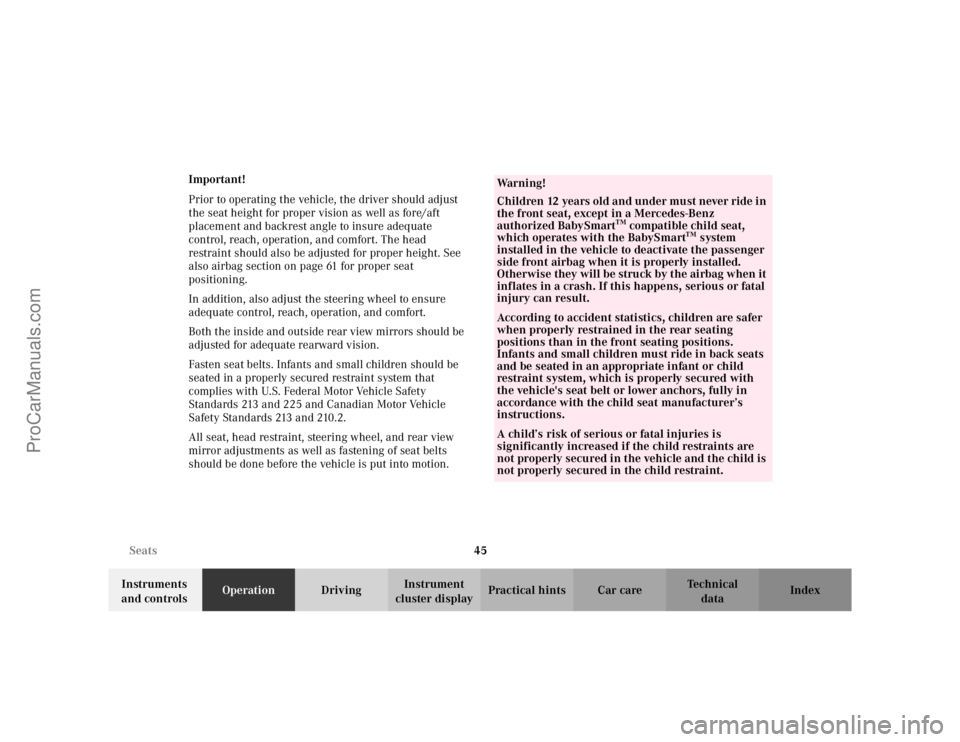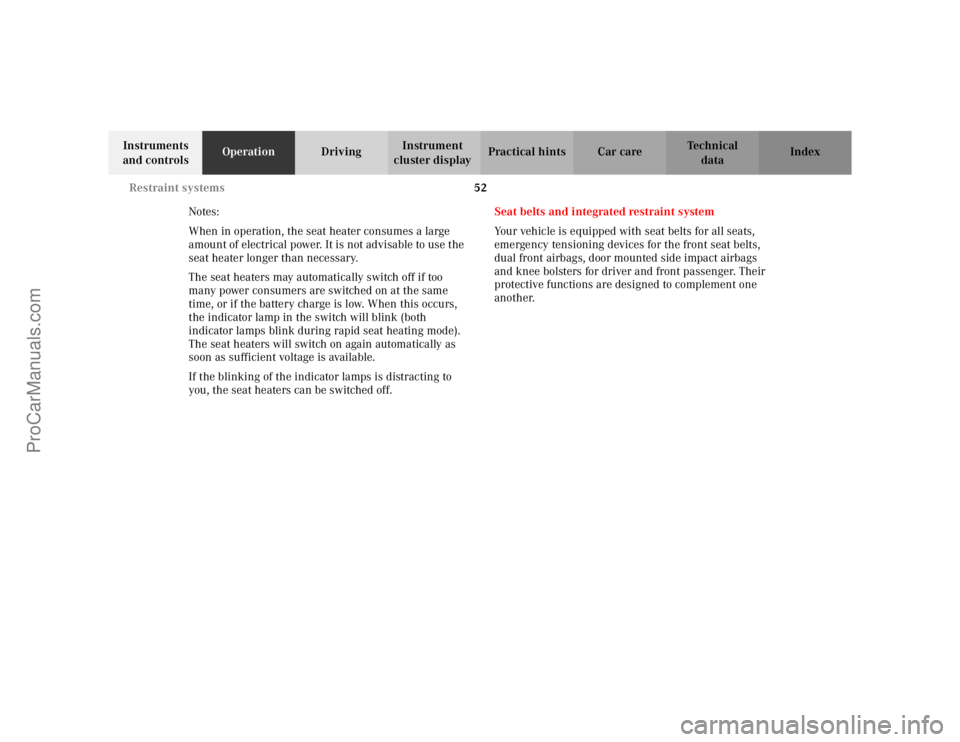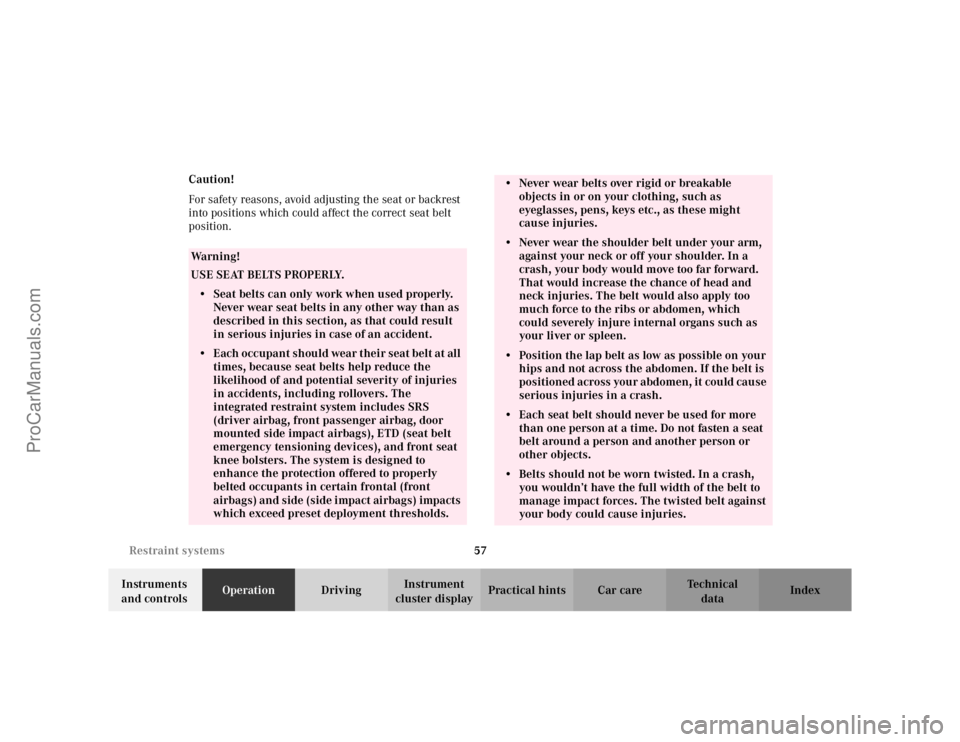2002 MERCEDES-BENZ CLK-CLASS airbag
[x] Cancel search: airbagPage 4 of 341

1 Contents
IntroductionProduct information .......................... 6
Operator’s manual ............................. 7
Where to find it ................................ 12
Reporting Safety Defects ................ 14Instruments and controlsInstruments and controls ............... 16
Center console .............................. 18
Overhead control panel ............... 19OperationVehicle keys ...................................... 22
Start lock-out .................................... 24
General notes on the central locking
system ........................................... 24
Central locking system ................... 25
Radio frequency and infrared
remote control .............................. 25
Opening and closing windows from
outside ........................................... 29
Panic button .................................. 30Mechanical keys .......................... 30
Doors ..................................................31
Central locking switch .................... 33
Automatic central locking .......... 34
Emergency unlocking in case of
accident ........................................ 34
Trunk ................................................. 35
Trunk lamp ....................................... 36
Trunk lid release switch ................ 37
Trunk lid emergency release ........ 38
Antitheft alarm system ................... 39
Tow-away alarm ............................... 40
Power seats, front ............................. 41
Front head restraints .................. 46
Roll bar and head restraints,
rear ............................................... 47
Backrest ............................................ 49
Multicontour seat ............................ 50
Heated seats ......................................51
Seat belts and integrated restraint
system .......................................... 52
Seat belts .......................................... 53
Seat belt nonusage warning
system ............................................ 54BabySmart
TM airbag deactivation
system ........................................... 59
Self-test BabySmart
TM without
special child seat installed ......... 59
Supplemental restraint system
(SRS) ............................................. 60
Emergency tensioning device
(ETD) ............................................. 60
Airbags .............................................. 61
Safety guidelines for the seat belt,
emergency tensioning device and
airbag ............................................. 67
Infant and child restraint
systems .......................................... 69
Child seat anchors- "LATCH",
type ............................................... 71
Adjusting telescoping steering
column .......................................... 73
Inside rear view mirror .................. 74
Antiglare night position .............. 74
Exterior rear view mirrors ............. 75
Instrument cluster ........................... 78
Indicator lamps in the instrument
cluster ........................................... 80
ProCarManuals.com
Page 6 of 341

3 ContentsParking brake .................................200
Driving instructions ...................... 201
Drive sensibly – save fuel ......... 201
Drinking and driving ................. 201
Pedals ........................................... 201
Power assistance ........................202
Brakes ..........................................202
Driving off ...................................203
Parking ........................................204
Tires .............................................204
Snow chains ................................207
Winter driving instructions ......207
Standing water ...........................209
Passenger compartment ...........209
Traveling abroad ........................209
Cruise control ................................. 210
Brake assist system (BAS) ............ 212
Antilock brake system (ABS) ....... 214
Electronic stability program
(ESP) ........................................... 216
What you should know at the gas
station .........................................220
Check regularly and before a long
trip ...............................................222
Instrument cluster displayMalfunction and indicator lamps in
the instrument cluster ............. 224
On-board diagnostic system Check
engine malfunction indicator
lamp ............................................. 224
Brake warning lamp .................. 225
Supplemental restraint system
(SRS) indicator lamp ................. 226
Fuel reserve and fuel cap
placement warning ................... 226
Electronic stability program (ESP)
— warning lamp .......................... 227
BAS/ESP malfunction indicator
lamp ............................................. 227
ABS malfunction indicator
lamp ............................................. 227
Telescoping steering column –
indicator lamp ............................ 228
Seat belt warning lamp ............. 228
Malfunction and indicator lamps in
the center console .................... 228
AIRBAG OFF indicator lamp .... 228
Roll bar warning lamp .............. 229Malfunction and warning messages
in the multifunction display ...230
DISPLAY DEFECTIVE (engine
control unit) ................................ 231
DISPLAY DEFECTIVE (several
systems) ....................................... 231
BATTERY/ALTERNATOR ...........232
ABS-SYSTEM ...............................233
BRAKE ASSIST ...........................233
BRAKE LINING WEAR ..............234
BRAKE FLUID .............................234
PARKING BRAKE .......................235
ENGINE FAN ...............................235
COOLANT (coolant level) ..........236
COOLANT TEMP. (coolant
temperature) ...............................237
LIGHTING SYSTEM ....................238
LIGHT SENSOR ...........................239
STEER. WHEEL ADJUST. ...........239
ENGINE OIL LEVEL ...................240
ELEC. STABIL. PROG. (Electronic
stability program) ...................... 241
REMOVE KEY ............................. 241
WASHER FLUID .........................242
ProCarManuals.com
Page 21 of 341

18 Instruments and controls
Te ch n i c a l
data Instruments
and controlsOperation DrivingInstrument
cluster displayPractical hints Car care Index
Center console1Soft top switch, see page 158
2ESP control switch, see page 218
3Program mode selector switch, see page 198
4Left power window switch (front), see page 142
5Right power window switch (front), see page 142
6Left power window switch (rear), see page 142
7Trunk lid release switch, see page 37
8Mirror adjustment switch, see page 75
9Right power window switch (rear), see page 142
10AIRBAG OFF indicator lamp, see page 228
ESP ESP
P68.10-2555-2710
12
3
6
7
8
9
5
4
ProCarManuals.com
Page 23 of 341

20
Te ch n i c a l
data Instruments
and controlsOperationDrivingInstrument
cluster displayPractical hints Car care Index
OperationVehicle keys ...................................... 22
Start lock-out .................................... 24
General notes on the central locking
system ........................................... 24
Central locking system ................... 25
Radio frequency and infrared
remote control .............................. 25
Opening and closing windows from
outside ........................................... 29
Panic button .................................. 30
Mechanical keys ........................... 30
Doors .................................................. 31
Central locking switch .................... 33
Automatic central locking .......... 34
Emergency unlocking in case of
accident ........................................ 34
Trunk ................................................. 35
Trunk lamp ....................................... 36
Trunk lid release switch ................. 37
Trunk lid emergency release ......... 38
Antitheft alarm system ................... 39
Tow-away alarm ................................ 40Power seats, front ............................. 41
Front head restraints .................. 46
Roll bar and head restraints,
rear ............................................... 47
Backrest ............................................ 49
Multicontour seat ............................ 50
Heated seats ......................................51
Seat belts and integrated restraint
system .......................................... 52
Seat belts .......................................... 53
Seat belt nonusage warning
system ............................................ 54
BabySmart
TM airbag deactivation
system .......................................... 59
Self-test BabySmart
TM without
special child seat installed ......... 59
Supplemental restraint system
(SRS) ............................................. 60
Emergency tensioning device
(ETD) ............................................ 60
Airbags ............................................... 61
Safety guidelines for the seat belt,
emergency tensioning device and
airbag ............................................. 67Infant and child restraint
systems .......................................... 69
Child seat anchors- "LATCH",
type ............................................... 71
Adjusting telescoping steering
column .......................................... 73
Inside rear view mirror .................. 74
Antiglare night position .............. 74
Exterior rear view mirrors ............. 75
Instrument cluster ........................... 78
Indicator lamps in the instrument
cluster ........................................... 80
Multifunction steering wheel,
multifunction display ................. 84
Trip and main odometer and sub
menu ............................................. 88
Audio systems .................................. 89
Radio .............................................. 89
CD player ....................................... 90
Cassette player ............................. 91
Telephone .......................................... 92
Telephone book ............................ 92
Redialing ....................................... 94
Incoming call ................................ 96
ProCarManuals.com
Page 48 of 341

45 Seats
Te ch n i c a l
data Instruments
and controlsOperationDrivingInstrument
cluster displayPractical hints Car care Index Important!
Prior to operating the vehicle, the driver should adjust
the seat height for proper vision as well as fore/aft
placement and backrest angle to insure adequate
control, reach, operation, and comfort. The head
restraint should also be adjusted for proper height. See
also airbag section on page 61 for proper seat
positioning.
In addition, also adjust the steering wheel to ensure
adequate control, reach, operation, and comfort.
Both the inside and outside rear view mirrors should be
adjusted for adequate rearward vision.
Fasten seat belts. Infants and small children should be
seated in a properly secured restraint system that
complies with U.S. Federal Motor Vehicle Safety
Standards 213 and 225 and Canadian Motor Vehicle
Safety Standards 213 and 210.2.
All seat, head restraint, steering wheel, and rear view
mirror adjustments as well as fastening of seat belts
should be done before the vehicle is put into motion.
Wa r n i n g !
Children 12 years old and under must never ride in
the front seat, except in a Mercedes-Benz
authorized BabySmart
TM compatible child seat,
which operates with the BabySmart
TM system
installed in the vehicle to deactivate the passenger
side front airbag when it is properly installed.
Otherwise they will be struck by the airbag when it
inflates in a crash. If this happens, serious or fatal
injury can result.
According to accident statistics, children are safer
when properly restrained in the rear seating
positions than in the front seating positions.
Infants and small children must ride in back seats
and be seated in an appropriate infant or child
restraint system, which is properly secured with
the vehicle's seat belt or lower anchors, fully in
accordance with the child seat manufacturer’s
instructions.A child’s risk of serious or fatal injuries is
significantly increased if the child restraints are
not properly secured in the vehicle and the child is
not properly secured in the child restraint.
ProCarManuals.com
Page 55 of 341

52 Restraint systems
Te ch n i c a l
data Instruments
and controlsOperationDrivingInstrument
cluster displayPractical hints Car care Index
Notes:
When in operation, the seat heater consumes a large
amount of electrical power. It is not advisable to use the
seat heater longer than necessary.
The seat heaters may automatically switch off if too
many power consumers are switched on at the same
time, or if the battery charge is low. When this occurs,
the indicator lamp in the switch will blink (both
indicator lamps blink during rapid seat heating mode).
The seat heaters will switch on again automatically as
soon as sufficient voltage is available.
If the blinking of the indicator lamps is distracting to
you, the seat heaters can be switched off.Seat belts and integrated restraint system
Your vehicle is equipped with seat belts for all seats,
emergency tensioning devices for the front seat belts,
dual front airbags, door mounted side impact airbags
and knee bolsters for driver and front passenger. Their
protective functions are designed to complement one
another.
ProCarManuals.com
Page 56 of 341

53 Restraint systems
Te ch n i c a l
data Instruments
and controlsOperationDrivingInstrument
cluster displayPractical hints Car care Index Seat belts
Important!
Laws i n mo st states and all Canadi an provi nc es require
seat belt use.
All U.S. states, the District of Columbia, the U.S.
territories and all Canadian provinces require the use of
child restraints that comply with U.S. Fedral Motor
Vehicle Safety Standards 213 and 225 and Canadian
Motor Vehicle Safety Standards 213 and 210.2.
For your safety and that of your passengers we strongly
recommend their use.
Wa r n i n g !
Children 12 years old and under must never ride in
the front seat, except in a Mercedes-Benz
authorized BabySmart
TM compatible child seat,
which operates with the BabySmart
TM system
installed in the vehicle to deactivate the passenger
side front airbag when it is properly installed.
Otherwise they will be struck by the airbag when it
inflates in a crash. If this happens, serious or fatal
injury will result.
According to accident statistics, children are safer
when properly restrained in the rear seating
positions than in the front seating positions.
Infants and small children must ride in back seats
and be seated in an appropriate infant or child
restraint system, which is properly secured with
the vehicle's seat belt or lower anchors, fully in
accordance with the child seat manufacturer’s
instructions.A child’s risk of serious or fatal injuries is
significantly increased if the child restraints are
not properly secured in the vehicle and the child is
not properly secured in the child restraint.
ProCarManuals.com
Page 60 of 341

57 Restraint systems
Te ch n i c a l
data Instruments
and controlsOperationDrivingInstrument
cluster displayPractical hints Car care Index Caution!
For safety reasons, avoid adjusting the seat or backrest
into positions which could affect the correct seat belt
position.
Wa r n i n g !
USE SEAT BELTS PROPERLY.• Seat belts can only work when used properly.
Never wear seat belts in any other way than as
described in this section, as that could result
in serious injuries in case of an accident.• E ach oc c upan t s houl d wear t hei r s ea t bel t a t al l
times, because seat belts help reduce the
likelihood of and potential severity of injuries
in accidents, including rollovers. The
integrated restraint system includes SRS
(driver airbag, front passenger airbag, door
mounted side impact airbags), ETD (seat belt
emergency tensioning devices), and front seat
knee bolsters. The system is designed to
enhance the protection offered to properly
belted occupants in certain frontal (front
airbags) and side (side impact airbags) impacts
which exceed preset deployment thresholds.
• Never wear belts over rigid or breakable
objects in or on your clothing, such as
eyeglasses, pens, keys etc., as these might
cause injuries.• Never wear the shoulder belt under your arm,
against your neck or off your shoulder. In a
crash, your body would move too far forward.
That would increase the chance of head and
neck injuries. The belt would also apply too
much force to the ribs or abdomen, which
could severely injure internal organs such as
your liver or spleen.• Position the lap belt as low as possible on your
hips and not across the abdomen. If the belt is
positioned across your abdomen, it could cause
serious injuries in a crash.• Each seat belt should never be used for more
than one person at a time. Do not fasten a seat
belt around a person and another person or
other objects.• Belts should not be worn twisted. In a crash,
you wouldn’t have the full width of the belt to
manage impact forces. The twisted belt against
your body could cause injuries.
ProCarManuals.com